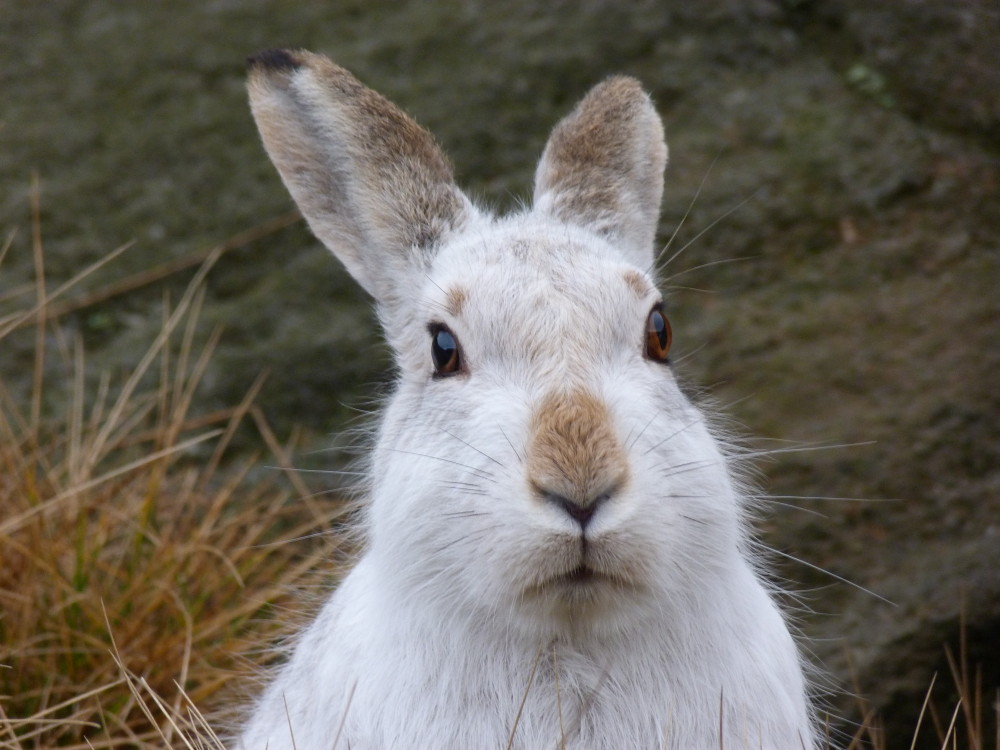Mountain (or Irish) hare

Status
Native and locally common in Scotland and Ireland
Population
135,000; about 2,400 in England
Scientific name
Lepus timidus
Mountain hares were found across much of the UK in prehistoric times but today they are widespread only in Ireland and parts of Scotland. There is a much smaller isolated population in the Peak District that is under threat. The Irish hare is an endemic subspecies of the mountain hare, native to Ireland, and is more closely related to European continental populations than to those in Scotland. In the 19th century, Scottish mountain hares were introduced into England and the Isle of Man for hunting.
The mountain hare is smaller than the brown hare and has shorter ears. They moult their grey coat in early winter, turning white to blend in with the snow on the uplands. They are very timid and mainly nocturnal, although they can be active during the day if undisturbed by humans. If danger is near, they crouch motionless with their ears down and at the last minute, can dart uphill at high speed. After about 50m, they stop to stand up on their hind legs and look back at what startled them. They are mainly solitary animals, especially when resting, but often graze in groups, feeding along well-trampled trails through long vegetation.
Head-body length: 45 – 60cm
Ear length: About same length as head
Weight: 2.5 – 4kg (females are on average slightly heavier than males)
Lifespan: Up to 10 years. Only 20% may survive their first year
Reproduction
Females typically have three litters per year between March and August. 1- 4 young (leverets) are born in each litter, fully furred and with their eyes open. The mother suckles them for about four weeks until they become independent.
Diet
Mainly heather; also moorland grasses and other plants.
Habitat
Heather moorland, grassland and rocky hilltops, usually above 300m.
Predators
Mainly foxes; also wildcats, dogs, stoats and golden eagle.
Threats
Populations periodically crash by up to 90%, because of increasing gut parasite loads. This predisposes mountain hare groups to vulnerability by other causes which can compound their decline. Deleterious vectors include hunting, climate change, competitive exclusion by the European brown hare, isolation in England (meaning no chance of inward migration). The impact of changing land use is unknown.
Conservation status
GB Red List: Near Threatened (NT).
Native, locally common in Ireland and Scotland. Some populations in Scotland have declined of more than 90% and the species is also at risk in England.
GB population size and distribution
GB population 135,000. The number last recorded for the Peak District was 2,400, fewer than previously reported. The best evidence suggests that the population outside of Ireland may be declining, but populations show large year-to-year changes. The British Trust for Ornithology’s Breeding Bird Survey, which records mammals a well as birds, shows a decline of 61% between 1995 and 2022. Mountain hares are present in the Highlands, Borders and south-west of Scotland, the Isle of Man, and throughout Ireland.
Did you know?
Mountain hares have heavily furred hindfeet, particularly in winter, which act like snow-shoes, helping to spread the animal’s weight so that they don’t sink into soft, deep snow. Their tracks are characteristically broader than those of the brown hare.
